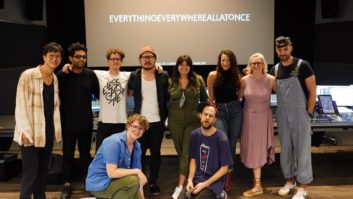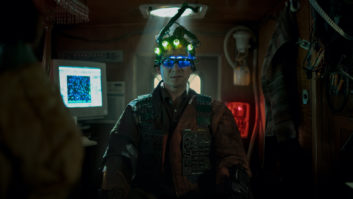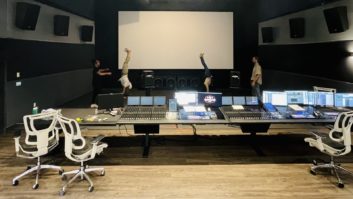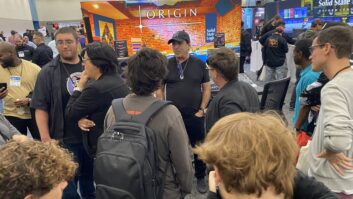2019 was a busy 25th anniversary year for Mobile TV Group, which remained true to its progressive and tech-savvy approach by launching two new mobile units into its 41-strong fleet. This initiative broke into new territory, creating the world’s first entirely SMPTE 2110 uncompressed IP-based mobile TV broadcast unit – ‘45 FLEX’ – with mobile unit ‘46 FLEX’ launching shortly after, and mobile unit ‘47 FLEX’ set to launch in Q1 of 2020.
The new dual-trailer units’ infrastructures are both based around the Grass Valley Kayenne K-Frame X IP switcher, an Evertz 384-port EXE 2.0 IP router and an Evertz Magnum control system, to offer 1080p capacity that would require at least a 3000×3000 baseband router. For audio, the new mobile units use Calrec’s Artemis digital broadcast consoles with audio-over-IP capabilities.
Fleet Services
Mobile TV Group predominantly services the U.S. sports markets, with units spread across the country, each run by around 50 engineers. The current count of 41 mobile units, including 15 dual-trailer rigs (Unit A and VMU-Unit B) that can run the group’s ‘dual-feed’ production concept – operations for both home and visiting teams from two spaces but with shared technical resources. Both the new 45 FLEX and 46 FLEX units are dual-trailer outfits, with 53-foot expanding trailers (to 16’6” wide) for Unit A, and 53-foot long (8’6” wide) for VMU-Unit B trailers.
Impressively, the group designs and integrates its own mobile units, using a strong permanent integration team at its Denver HQ. At any time, visitors can find at least one mobile unit is built.
As Director of Engineering for Mobile TV for the past seven years (following nine years based in Michigan as an engineer for the company), Peter Wehner has long-been drawn to the tech side of the industry: “We always get the latest tech, and it’s always changing. Of course, I also get to work with a lot of different people from different backgrounds, and I get to travel to some amazing sporting events. The mobile unit is where it all happens, and I’m never bored.
Technology Pioneers
Wehner feels that a willingness and ability to adopt the right technologies at the right time is one of the things that sets Mobile TV Group apart from the crowd. It has a healthy, pioneering track-record, with some of the first HD mobile units in North America, the first ground-up 4K UHD mobile unit and the first HDR broadcast in America. “We pride ourselves on being the first,” he says. “We have a talent for getting in there at just the right time, with improvements and facilities that always make things better for our clients.”
All Mobile TV Group units are numbered sequentially as they are finished and brought on-line. With only one exception, all new mobile units since number 29 have been equipped with Calrec Artemis audio consoles, complete with Bluefin2 processing and integrated Hydra2 routing. The fader count varies between 48 and 64 across the fleet, but all have the Artemis ‘Beam’ package, which offers 340 channel processing paths per console.
Wehner makes the point that it’s important for the mobile unit environment to be comfortable and familiar to all mixers. One way to ensure that is to go with industry standard tools, such as Calrec consoles. “Our clients will hire freelance operators who may or may not have seen our mobile units before. Being able to come in and get working straightaway is incredibly important.”
He also sees the flexibility of Calrec as a prime attribute, particularly given the variety of events many of the group’s mobile units are used on. “We primarily produce sports, but we also do entertainment and corporate shows. The Calrec consoles can handle anything, for whatever market we’re dealing with.”
One thing that all Mobile TV Group engineers look for is great service and support, “and that’s something Calrec is well known for,” he adds. “Most of our engineers do not have audio backgrounds – they’re not operators. The willingness of Calrec to take the time to make sure they really understand how the console works, what the signal flow is and so on, is really appreciated. We don’t see that with a lot of other manufacturers.”
In order to integrate Calrec into the new IP mobile units, Mobile TV Group relies on the Calrec audio-over-IP I/O unit, which provides a Hydra2 AoIP interface for up to 512×512 channels using AES67 or Ravenna. That IP connection goes directly to the unit’s Evertz router. “Now, we can connect all of our audio with a couple of pieces of fiber,” says Wehner. “Taking the units’ infrastructures into consideration, that’s amazing for ease of connectivity and use. Of course, it also helps on weight, which is a big issue on these trailers.”
FLEX-ability
Wehner sees the new units, and their components, as vital parts of an ‘everything everywhere’ future: “Every feed can be available everywhere,” he says. “That, in turn, has now become an expectation for clients who understandably don’t want any restrictions. In the past, there’s always been a limit on how many audio channels we can send between units. Now, those restrictions are going away thanks to the latest audio technologies, like those provided by Calrec.”
As a world first, the natively IP Mobile TV Group 45 FLEX mobile unit represents a big step forward in many ways. Wehner acknowledges that it’s not the first time IP has been core to a mobile unit, but says it is the first time that IP has completely taken over. He notes that Mobile TV Group’s plan was always to build an IP-based mobile unit, but only once it was feasible to natively connect all core devices, including the switcher, the cameras, replay devices, multi-viewers and, of course, the audio console.
“There are other mobile units out there that say they are IP,” he explains. “But that normally just refers to the routing. Signals get converted back to baseband at many of the devices. We didn’t think there was a big advantage to having an IP core and then having to convert everything. Once the technology caught up with our ambition, we went ahead and built 45 FLEX and, subsequently, the 46 FLEX. Now we’re looking forward to 47 and 48!”
360-degree views of the FLEX mobile unit are available here.






